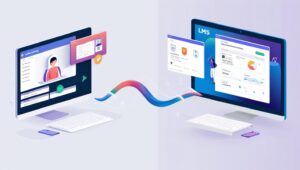Online tests have become an essential assessment component in today’s educational environment, allowing institutions to assess students from a distance without sacrificing integrity. It can be difficult to find the ideal proctoring solution that strikes a balance between cost, usability, and security. Different programs have different security requirements depending on their stakes and testing environments. Proctoring options are now more varied and flexible than ever, ranging from AI-driven solutions to live proctoring with human oversight. To ensure academic integrity across various use cases, this thought piece will examine how institutions can match their exam security requirements to appropriate proctoring solutions.
Assessing Exam Stakes: Matching Proctoring Solutions to Needs
Knowing the stakes of your exams is the first step in choosing a suitable proctoring solution. Because they affect career paths and public safety, high-stakes exams—like those in nursing or other professional licensure programs—frequently call for greater monitoring. On the other hand, less important tests, such as midterms or weekly quizzes, might not need as much attention.
Live proctoring, which involves a human proctor in real time for high-stakes exams, provides the highest level of oversight. Exam integrity is maintained at the highest level in these situations because proctors can step in immediately if questionable behavior occurs. On the other hand, AI-enabled solutions that use behavioral analytics, screen tracking, and face recognition to identify possible cheating without human intervention might be adequate for exams with lower stakes.
Considering Exam Formats and Environments
When choosing a proctoring solution, the type of exam—open-book, closed-book, or practical—also matters a lot. Strong monitoring using multiple camera angles and stringent browser lockdowns is frequently necessary in high-security environments, such as those mandated by medical schools or nursing certification exams. For exams where total control over the test environment is needed, a proctoring solution with a “secure browser” feature, for instance, can limit access to unapproved websites or software.
Some proctoring systems offer dual-camera configurations, which enable proctors to monitor the test-taker and their environment. A more flexible proctoring solution that permits screen sharing and workspace monitoring may better-fit programs that demand situational awareness, like engineering or architecture, where students may require tangible tools or models.
Evaluating Proctoring Levels
The level of proctoring is another key consideration when selecting a solution. There are three primary types:
- Automated proctoring relies on machine learning algorithms to monitor test-takers activities in real-time. It’s suitable for exams with medium security needs, offering features like facial recognition, audio analysis, and eye-tracking. AI-based solutions are ideal for large-scale testing, as they minimize human involvement, making them both scalable and cost-effective.
- Hybrid Spot Check proctoring uses video and screen data in case a human proctor triggers an incident during the exam. This approach is efficient for tests that may not require live oversight but still benefit from thorough analysis on a need-basis, such as final exams or semester-end assessments.
- Live proctoring involves real-time monitoring by a human proctor, either through one-on-one supervision or a group view. Live proctoring is best for high-stakes exams, such as professional certifications or nursing programs, where any incident of cheating could have serious consequences. This type of proctoring allows immediate intervention if suspicious behavior is detected, ensuring enhanced exam security.

Use Cases: Matching Proctoring Solutions with Institutional Requirements
Different types of institutions can benefit from customized proctoring solutions:
- K-12 Schools: Typically, K-12 assessments are lower stakes, making AI-based proctoring or simple browser lockdowns adequate for most use cases. AI monitoring with minimal intrusiveness is ideal, as it respects students’ privacy while providing sufficient oversight.
- Higher Education: Colleges and universities offer various exams with varying security requirements. For instance, undergraduate courses may rely on AI-based or record-and-review proctoring for exams. At the same time, graduate programs, especially in fields like medicine, law, or engineering, could benefit from live proctoring due to these exams’ higher stakes and complexity.
- Professional Certification and Licensing Bodies: High-stakes certification exams, such as those for nursing, real estate, or IT, require live proctoring to ensure the highest level of security. In these cases, live human intervention helps safeguard against cheating and ensures regulatory compliance.
Each institution has unique needs, but a flexible proctoring provider can offer tailored options to suit different exam formats, stakes, and environments, aligning with each program’s specific requirements.
Balancing Privacy, Security, and Budget
One of the biggest challenges in choosing a proctoring solution is balancing privacy, security, and budget. While live proctoring provides maximum oversight, it also incurs higher costs due to the need for human proctors. On the other hand, AI-based proctoring solutions are more budget-friendly but may lack the immediate intervention capabilities of live proctoring.
Institutions should also consider data privacy and compliance with regulations like FERPA in the U.S. or GDPR in Europe, as proctoring solutions often involve handling sensitive student data. To ensure that student data is protected, choosing a proctoring provider that offers secure data handling and complies with relevant privacy laws is essential.
Proctortrack, for instance, is SOC 2 Type 2 and ISO/IEC 27001 certified, demonstrating a commitment to data security and privacy. Institutions can rely on such providers for secure, compliant proctoring that meets regulatory requirements.
Summing up
Choosing the right proctoring solution requires thoroughly understanding an institution’s exam requirements, budget constraints, and data privacy needs. High-stakes exams benefit from live proctoring with human oversight, offering the highest level of exam security. In contrast, lower-stakes exams can often rely on AI-based monitoring for a more cost-effective solution. Educational providers can ensure exam integrity by matching proctoring features to exam formats, stakes, and institutional types. This happens without compromising student privacy or exceeding their budget. With the right proctoring partner, institutions can meet diverse testing needs, foster a secure online testing environment, and uphold the credibility of their academic programs.











